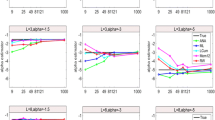Abstract
Classification of polarimetric synthetic aperture radar (SAR) images into different ground covers becomes challenging when the terrain under consideration is heterogeneous in nature. A finite mixture model-based Wishart mixture model (WMM) classifier can efficiently incorporate heterogeneity of terrain using multiple Wishart components. The expectation-maximization (EM) is the most widely used algorithm for learning parameters of such statistical models. However, the convergence of the EM algorithm is very slow. Moreover, the information contained in the polarimetric SAR images is in complex numbers and the size of the data is often very large. Therefore, they incur a large amount of computational overhead. The training of the classifier becomes very slow due to these reasons. In this paper, a k-maximum likelihood estimator (k-MLE) algorithm is employed for learning of the parameters in WMM classifier. As k-MLE is an iterative process, different algorithm initialization approaches such as random, global K-means, and k-MLE++ are analyzed. The algorithm is compared with the traditional EM algorithm in terms of classification accuracy and computational time. The experiments are performed on six different full polarimetric SAR datasets. The results show that the classification accuracy using k-MLE is comparable to the traditional EM algorithm while being more computationally efficient. The initialization using k-MLE++ results in better modeling compared to random and global K-means.
Access this chapter
Tax calculation will be finalised at checkout
Purchases are for personal use only
Similar content being viewed by others
References
Ahishali, M., Kiranyaz, S., Ince, T., Gabbouj, M.: Classification of polarimetric SAR images using compact convolutional neural networks. GISci. Remote Sens. 58(1), 28–47 (2021). https://doi.org/10.1080/15481603.2020.1853948
ASF: Dataset: AIRSAR, NASA 1991. https://search.asf.alaska.edu/. Accessed ASF DAAC 09 April 2021
Couvreur, C.: The EM Algorithm: A Guided Tour, pp. 209–222. Birkhäuser Boston, Boston (1997). https://doi.org/10.1007/978-1-4612-1996-5_12
Dempster, A.P., Laird, N.M., Rubin, D.B.: Maximum likelihood from incomplete data via the EM algorithm. J. Roy. Stat. Soc. Ser. B (Methodol.) 39(1), 1–22 (1977)
Freitas, C.C., Frery, A.C., Correia, A.H.: The polarimetric G distribution for SAR data analysis. Environmetrics Official J. Int. Environmetrics Soc. 16(1), 13–31 (2005)
Gadhiya, T., Roy, A.K.: Superpixel-driven optimized Wishart network for fast polsar image classification using global \({k}\)-means algorithm. IEEE Trans. Geosci. Remote Sens. 58(1), 97–109 (2020). https://doi.org/10.1109/TGRS.2019.2933483
Gao, W., Yang, J., Ma, W.: Land cover classification for polarimetric SAR images based on mixture models. Remote Sens. 6(5), 3770–3790 (2014). https://doi.org/10.3390/rs6053770
Hua, W., Xie, W., Jin, X.: Three-channel convolutional neural network for polarimetric SAR images classification. IEEE J. Sel. Top. Appl. Earth Observ. Remote Sens. 13, 4895–4907 (2020). https://doi.org/10.1109/JSTARS.2020.3018161
IETR: San Francisco polarimetric SAR datasets (2019). https://ietr-lab.univ-rennes1.fr/polsarpro-bio/san-francisco/
Lee, J.S., Grunes, M.R., Kwok, R.: Classification of multi-look polarimetric SAR imagery based on complex Wishart distribution. Int. J. Remote Sens. 15(11), 2299–2311 (1994). https://doi.org/10.1080/01431169408954244
Lee, J.S., Pottier, E.: Polarimetric Radar Imaging: From Basics to Applications. CRC Press, Boca Raton (2009)
Lee, J.S., Schuler, D.L., Lang, R.H., Ranson, K.J.: K-distribution for multi-look processed polarimetric SAR imagery. In: Proceedings of IGARSS 1994 - 1994 IEEE International Geoscience and Remote Sensing Symposium, vol. 4, pp. 2179–2181 (1994). https://doi.org/10.1109/IGARSS.1994.399685
Likas, A., Vlassis, N., Verbeek, J.J.: The global k-means clustering algorithm. Pattern Recogn. 36(2), 451–461 (2003)
Liu, H., Luo, R., Shang, F., Meng, X., Gou, S., Hou, B.: Semi-supervised deep metric learning networks for classification of polarimetric SAR data. Remote Sens. 12(10) (2020). https://www.mdpi.com/2072-4292/12/10/1593
Liu, X., Jiao, L., Liu, F.: PoLSF: PoLSAR image dataset on San Francisco. arXiv preprint arXiv:1912.07259 (2019)
Nielsen, F.: \(k\)-MLE: a fast algorithm for learning statistical mixture models. In: 2012 IEEE International Conference on Acoustics, Speech and Signal Processing (ICASSP), pp. 869–872 (2012). https://doi.org/10.1109/ICASSP.2012.6288022
Saint-Jean, C., Nielsen, F.: Hartigan’s method for \(k\)-MLE: mixture modeling with Wishart distributions and its application to motion retrieval. In: Nielsen, F. (ed.) Geometric Theory of Information. SCT, pp. 301–330. Springer, Cham (2014). https://doi.org/10.1007/978-3-319-05317-2_11
Schwander, O., Nielsen, F.: Fast learning of gamma mixture models with \(k\)-MLE. In: Hancock, E., Pelillo, M. (eds.) Similarity-Based Pattern Recognition, pp. 235–249. Springer, Heidelberg (2013)
Schwander, O., Schutz, A.J., Nielsen, F., Berthoumieu, Y.: k-MLE for mixtures of generalized gaussians. In: Proceedings of the 21st International Conference on Pattern Recognition (ICPR2012), pp. 2825–2828 (2012)
STEP-ESA: Polsarpro v6.0 (biomass edition) toolbox. https://step.esa.int/main/toolboxes/polsarpro-v6-0-biomass-edition-toolbox/
The Scikit-YB developers: Elbow method - yellowbrick v1.2.1 documentation. https://www.scikit-yb.org/en/latest/api/cluster/elbow.html
Yang, W., Yang, X., Yan, T., Song, H., Xia, G.S.: Region-based change detection for polarimetric SAR images using Wishart mixture models. IEEE Trans. Geosci. Remote Sens. 54(11), 6746–6756 (2016). https://doi.org/10.1109/TGRS.2016.2590145
Author information
Authors and Affiliations
Corresponding author
Editor information
Editors and Affiliations
Rights and permissions
Copyright information
© 2022 The Author(s), under exclusive license to Springer Nature Switzerland AG
About this paper
Cite this paper
Chaudhari, N., Mitra, S.K., Mandal, S., Chirakkal, S., Putrevu, D., Misra, A. (2022). Polarimetric SAR Classification: Fast Learning with k-Maximum Likelihood Estimator. In: Raman, B., Murala, S., Chowdhury, A., Dhall, A., Goyal, P. (eds) Computer Vision and Image Processing. CVIP 2021. Communications in Computer and Information Science, vol 1567. Springer, Cham. https://doi.org/10.1007/978-3-031-11346-8_25
Download citation
DOI: https://doi.org/10.1007/978-3-031-11346-8_25
Published:
Publisher Name: Springer, Cham
Print ISBN: 978-3-031-11345-1
Online ISBN: 978-3-031-11346-8
eBook Packages: Computer ScienceComputer Science (R0)




